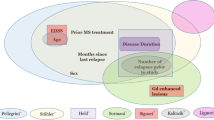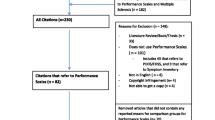Abstract
Objectives
The EDMUS system is a clinical database specifically tailored to the description of multiple sclerosis (MS). The EVALUED (Evaluation of the EDMUS system) study is an European project with two objectives: 1) to assess the inter-examiner reliability of the whole EDMUS system; 2) to validate the EDMUS-Grading Scale (EGS),which is a simplified version of the Kurtzke Disability Status Scale (DSS).
Methods
The protocol included 12 neurologists working in pairs within six European centres (Bari, Basel, Florence, London, Lyon, Würzburg). They assessed independently 30 MS patients in their centre, filling in the EDMUS forms. The reliability of the system was assessed on selected key items in the history of the MS onset, the clinical course and the disease course classification. The clinical examination of the patients permitted an assessment of the Kurtzke Expanded Disability Status Scale (EDSS) and the EGS. Level of agreement was measured in terms of kappa and weighted kappa indexes whenever appropriate.
Results
The study included 180 patients with definite or probable MS of whom 37% were males. Age was 35.8±9.6 years (mean ± SD), disease duration 7.8±5.7 years, and mean EDSS score 4.1±2.2. The disease course was relapsing-remitting in 67%, secondary progressive in 22%, and progressive from disease onset in 11%. For key items of the history, the inter-examiner reliability level ranged from moderate to excellent. Concerning the disability scales, perfect agreement was reached in 59 % for EDSS and 78% for EGS. The close correlation and linear association (r=0.94, p<0.0001) between both scales demonstrated EGS’s construct validity.
Conclusion
The EDMUS system allows a consistent clinical description of MS using a common language. This standardized follow-up of MS patients is valuable especially in studies requiring a critical mass of informative patients.
Similar content being viewed by others
References
Altman DG, Bland JM (1983) Measurement in medicine: the analysis of method comparison studies. Statistician 32:307–317
Amato MP, Fratiglioni L, Groppi C, Siracusa G, Amaducci L (1988) Interrater reliability in assessing functional systems and disability on Kurtzke scale in multiple sclerosis. Arch Neurol 45:746–748
Bland JM, Altman DG (1986) Statistical methods for assessing agreement between two methods of clinical measurement. Lancet 8:307–310
Cohen J (1960) A coefficient of agreement for nominal scales. Educational and psychological measurement 20:37–46
Cohen J (1968) Weighted Kappa: nominal scale agreement with provision for scaled disagreement on partial credit. Psychol Bull 70:213–220
Confavreux C (1994) Establishment and use of multiple sclerosis registers. Ann Neurol 36:S136–S139
Confavreux C, Aimard G, Devic M (1980) Course and prognosis of multiple sclerosis assessed by the computerized data processing of 349 patients. Brain 103:281–300
Confavreux C, Compston DAS, Hommes OR, McDonald WI, Thompson AJ (1992) EDMUS, a European database for multiple sclerosis. J Neurol Neurosurg Psychiatry 55:671–676
Confavreux C, Hours M, Moreau T, Cortinovis-Tourniaire P, Grimaud J for the participants to EDMUS European Concerted Action (1996) Clinical databasing in multiple sclerosis: EDMUS and the European effort. In: Abramsky O, Ovadia H (eds) Frontiers in Multiple Sclerosis Clinical Research and Therapy. Martin Dunitz Ltd, London, pp 299–312
Confavreux C, Hutchinson M, Hours M, Cortinovis-Tourniaire P, Moreau T, and the Pregnancy in Multiple Sclerosis Group (1998) Rate of pregnancy-related relapse rate in multiple sclerosis. N Engl J Med 339:285–291
Confavreux C, Paty DW (1995) Current status of computerization of multiple sclerosis clinical data for research in Europe and North-America: The EDMUS/MS-COSTAR connection. Neurology 45:573–576
Confavreux C, Suissa S, Saddier P, Bourdès V, Vukusic S, and the Vaccines in Multiple Sclerosis Group (2001) Vaccinations and the risk of relapse in multiple sclerosis. N Engl J Med 344:319–326
Confavreux C, Vukusic S, Moreau T, Adeleine P (2000) Relapses and progression of disability in multiple sclerosis. N Engl J Med 343:1430–1438
Confavreux C, Vukusic S, Adeleine P (2003) Early clinical predictors and progression of irreversible disability in multiple sclerosis: an amnesic process. Brain 126:770–782
Edan G, Miller DH, Clanet M, Confavreux C, Lyon-Caen O, Lubetzki C, Brochet B, Berry I, Rolland Y, Froment JC, Cabanis E, Iba-Zizen MT, Gandon JM, Lai HM, Moseley I, Sabouraud O (1997) Therapeutic effect of mitoxantrone combined with methylprednisolone in multiple sclerosis: a randomised multicenter study of active disease using MRI and clinical criteria. J Neurol Neurosurg Psychiatry 62:112–118
Feinstein AR (1985) Statistical indexes of association. In Feinstein AR (ed) Clinical epidemiology: the architecture of clinical research. WB Saunders Co, Philadelphia
Fleiss JL, Schrout PE (1978) Approximate interval estimation for a certain intraclass correlation coefficient. Psychometrika 43:259–262
Francis DA, Bain P, Swan AV, Hughes RAC (1991) An assessment of disability rating scales used in multiple sclerosis. Arch Neurol 48:299–301
Gayou A, Brochet B, Dousset V (1997) Transitional progressive multiple sclerosis: a clinical and imaging study. J Neurol Neurosurg Psychiatry 63:396–398
Goodkin DE, Cookfair D, Wende K, Bourdette D, Pullicino P, Scherokman B, Whitahm R (1992) Inter- and intrarater scoring agreement using grades 1.0 to 3.5 of the Kurtzke Expanded Disability Status Scale (EDSS). Multiple Sclerosis Collaborative Research Group. Neurology 42:859–863
Hobart J, Lamping DL, Thompson A (1996) Evaluating neurological outcome measures: the bare essentials. J Neurol Neurosurg Psychiatry 60:127–130
Hobart J, Lamping D, Fitzpatrick R, Riazi A, Thompson A (2001) The Multiple Sclerosis Impact Scale (MSIS-29). A new patient-based outcome measure. Brain 124:962–973
Kremenchutzky M, Cottrel DA, Rice GPA, Hader W, Baskerville J, Koopman W, Ebers GC (1999) The natural history of multiple sclerosis: a geographically based study. 7. Progressive-relapsing and relapsing-progressive multiple sclerosis: a re-evaluation. Brain 122:1941–1950
Kurtzke JF (1961) On the evaluation of disability in multiple sclerosis. Neurology 11(22):686–694
Kurtzke JF (1965) Further notes on disability evaluation in multiple sclerosis, with scale modifications. Neurology 15:654–661
Kurtzke JF (1983) Rating neurologic impairment in multiple sclerosis and expanded disability status scale (EDSS). Neurology 33:1444–1452
Landis JR, Koch GG (1977) The measurement of observer agreement for categorical data. Biometrics 33:15–173
Lublin FD, Reingold SC, for the National Multiple Sclerosis Society (USA) Advisory Committee on Clinical Trial of New Agents in Multiple Sclerosis (1996) Defining the clinical course of multiple sclerosis: results of an international survey. Neurology 46:907–911
Noseworthy JH, Vandenvoort MK, Wong CJ, Ebers GC (1990) Interrater variability with the Expanded Disability Status Scale (EDS) and Functional Systems (FS) in a multiple sclerosis clinical trial. The Canadian Cooperation MS Study Group. Neurology 40:971–975
Poser CM, Paty DW, Scheinberg L,Mc-Donald WI, Davis FA, Ebers GC, Johnson KP, Sibley WA, Silberberg DH, Tourtellotte WW (1983) New diagnosis criteria for multiple sclerosis: guidelines for research protocols. Ann Neurol 13:227–231
Robertson NP, Clayton D, Fraser M, Deans J, Compston DAS (1996) Clinical concordance in sibling pairs with multiple sclerosis. Neurology 47:347–352
Rudick R, Antel J, Confavreux C, Cutter G, Ellison G, Fischer J, Lublin F, Miller A, Petkan J, Rao S, Reingold S, Syndulko K, Thompson A, Wallenberg J, Weinshenker B, Willoughby E (1996) Clinical outcomes assessment in multiple sclerosis. Ann Neurol 40:469–479
Rudick R, Antel J, Confavreux C, Cutter G, Ellison G, Fischer J, Lublin F, Miller A, Petkan J, Rao S, Reingold S, Syndulko K, Thompson A, Wallenberg J, Weinshenker B, Willoughby E (1997) Recommendations from the National Multiple Sclerosis Society clinical outcomes assessment task force. Ann Neurol 42:379–382
Schumacher GA, Beebe G, Kibler RF, et al. (1983) Problems of experimental trials of therapy in MS: report by the panel on the evaluation of experimental trials of therapy in MS. Ann Neurol 13:227–231
Sharrack B, Hughes RAC, Soudain S, Dunn G (1999) The psychometric properties of clinical rating scales used in multiple sclerosis. Brain 122:141–159
Totaro R, Marini C, Cialfi A, Giunta M, Carolei A (2000) Prevalence of multiple sclerosis in the L’Aquila district, Central Italy. J Neurol Neurosurg Psychiatry 68:349–352
Trojano M, Avolio C, Manzari C, De Robertis F, Serio G, Livrea P (1995) Multivariate analysis of predictive factors of multiple sclerosis with a validate method to assess clinical events. J Neurol Neurosurg Psychiatry 58:300–306
Trojano M, Avolio C, Simone IL, Defazio G, Manzari C, De Robertis F, Calo A, Livrea P (1996) Soluble intercellular adhesion molecule-1 in serum and cerebrospinal fluid of clinically active relapsing-remitting multiple sclerosis: Correlation with Gd-DTPA magnetic resonance imaging enhancement and cerebrospinal findings. Neurology 47:1535–1541
Trojano M, Liguori M, Bosco Zimatore G, Bugarini R, Avolio C, Paolicelli D, Giuliani F, De Robertis F,Marrosu MG, Livrea P (2002) Age-related disability in multiple sclerosis. Ann Neurol 51(4):475–480
Tukey JW (1977) Tukey exploratory data analysis. In: Reading, MA: Addison, Weseley
Weinshenker BG, Bass B, Rice GPA, Noseworthy JH, Carriere W, Baskerville J, Ebers GC (1989) The natural history of multiple sclerosis: a geographically based study. I. Clinical course and disability. Brain 112:133–146
Weinshenker BG, Bass B, Rice GPA, Noseworthy JH, Carriere W, Baskerville J, Ebers GC (1989) The natural history of multiple sclerosis: a geographically based study. II. Predictive value of the early clinical course. Brain 112:1419–1428
Weinshenker BG, Rice GPA, Noseworthy JH, Carriere W, Baskerville J, Ebers GC (1991) The natural history of multiple sclerosis: a geographically based study. III. Multivariate analysis of predictive factors and models of outcome. Brain 114:1045–1056
Willoughby EW, Paty DW (1988) Scales for rating impairment in multiple sclerosis: a critique. Neurology 38:1793–1798
Author information
Authors and Affiliations
Corresponding author
Additional information
for the Evaluation of the EDMUS system (EVALUED) Study Group
M. P. Amato and J. Grimaud contributed equally to the study. The members of the Study Group are listed in appendix.
Rights and permissions
About this article
Cite this article
Amato, M.P., Grimaud, J., Achiti, I. et al. European validation of a standardized clinical description of multiple sclerosis. J Neurol 251, 1472–1480 (2004). https://doi.org/10.1007/s00415-004-0567-0
Received:
Revised:
Accepted:
Issue Date:
DOI: https://doi.org/10.1007/s00415-004-0567-0




